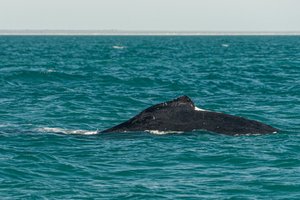Advertisement
Published: March 17th 2022

 Humpback whale
Humpback whale
Pathetic isn't it. I took about thirty shots and that's the best I could do.We spend the morning chilling, and then head off for an afternoon of whale watching. We climb into a dinghy on Gantheaume Beach. The tide's out and we still seem to be a long way from the water's edge. No problem there however; it seems that our dinghy also has a set of wheels to do the work until we hit the water, and the propeller is then able to take over and run us out to our cruise boat.
Our guide for the afternoon is a young marine biologist who introduces herself as Lucy. She tells us that the whales we'll be looking for are of the humpback variety. They migrate through here in winter to mate before heading back down to the Antarctic in summer. They also give birth in these warmer climes, as the cubs' blubber is not thick enough to keep them warm enough to survive in the colder polar waters. They typically grow to around fifteen metres and can weigh up to 40 tons. They're apparently a particularly popular species with whale watchers due to their surface behaviours. These include the well-known breaching, but also a smorgasbord of less familiar behaviours which sound like they'd
be at home on the program at the Olympic gymnastics - “spy-hopping, lob-tailing, tail slapping, pectoral fin slapping, peduncle throwing, charging and parrying”.
We seem to be heading a long way out to sea, and are being implored to look out for any signs of whales. Our crew is clearly determined that we actually see some, which probably isn’t too surprising seeing as we’ve been told we’ll get our money back if we don’t. I assume they’ll give up at some stage before we run out of petrol.
Someone spies a whale breaching in the far distance. It's a long way away, but looks spectacular just the same. We speed towards it. We see more, mostly just poking the top parts of their bodies above the surface momentarily while they breathe. I get my camera ready to take the award winning shot of a large specimen breaching spectacularly right in front of me in the middle of the frame. I scan the lens backwards and forwards looking for any signs of imminent action. I keep scanning, and scanning..... My arms are getting tired. I put the lens down for a rest. As soon as I’ve done this a
large specimen breaks the surface just where I was pointing, but I’m too slow to capture it. Hmmm. I decide to start the scanning process again - back and forth, back and forth..... My arms are about to drop off. “There’s one” I hear someone scream. But wait, it’s on the other side of the boat, so I miss it again. This routine goes on for the best part of an hour after which my arms are dead, I've gone cross eyed, and I’m still no closer to getting my dream shot. Issy says I should give up and just soak in the experience. I’m sure she’s right, but I’m feeling a bit discouraged. I’ve seen spectacular pictures of whales in mid-air in wildlife magazines, and am now wondering just how their photographers managed to capture them. The only thing I can come up with is that they’ve got a dozen or so cameras set up on tripods in a circle on the top of a boat, and someone’s invented a sensor to make them go off only when a whale comes into view. It's either that or all the pictures have been photoshopped.
Lucy tells us a bit
about the famous whale songs, and then throws a microphone into the water. It sure is noisy down there. Apparently the songs last for ten to twenty minutes at a time and are repeated for hours on end. She tells us that all males sing the same song, but the song then changes each season. This seems extraordinary. What is possibly more extraordinary is that someone’s been able to work this out from what sounds to us like a pleasant but very confused and seemingly random cacophony of noise. I assume she didn’t just make the fact up.
Back on the beach, the tide's gone out even further. Our wheeled dinghy seems to be at risk of getting bogged in the sand, so we need to disembark and walk the remaining kilometre or so up the rest of the beach to the bus. We’re told that two cars got bogged here last night. I wonder what happened after that. There's no sign of them now, so hopefully they’re not out there with the whales.
We dine at the Wharf Restaurant. We followed signs to it yesterday down by the port, where you’d think they’d put a restaurant called The Wharf. We couldn’t find it, and the restaurant we're at tonight is about as far from the coast as you could get and still be in Broome. I don’t think they’re into logical names here; it’s right next to the Sydney Cove Oyster Bar….
Advertisement
Tot: 0.047s; Tpl: 0.011s; cc: 7; qc: 23; dbt: 0.0273s; 1; m:domysql w:travelblog (10.17.0.13); sld: 1;
; mem: 1.1mb







